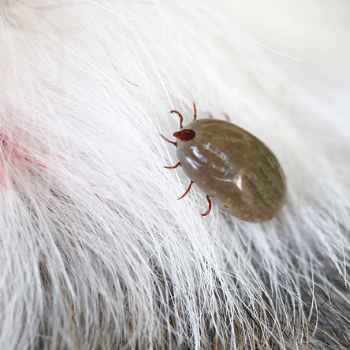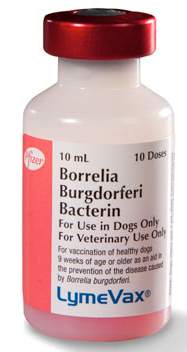Lyme Disease in Dogs

By Janice Jones |Last updated February 6, 2020
Lyme disease
in dogs is one of those devious health problems that can affect your dog,
not to mention other species as well as Humans.
It
is caused by a bacterium (Borrelia burgdorferi) carried by an infected tick, the
black-legged tick, Ixodes scapularis, which is also known as the small deer tick.
The disease is most common in the
northeastern U.S. and northern mid-west.
Named after
a town in Connecticut, It was not even recognized in humans until 1975 but
since then, scientists have found that it also occurs in horses, cattle, and
cats.
Many species of birds and wildlife
especially mice, harbor the disease without showing outward signs and serve as
the reservoirs for the tick infections.
Incidence of the disease increased in the 1980s and is now one of the
most common tick-borne diseases in humans and dogs.
The CDC
offers a map to help pinpoint where the majority of cases have been reported,
but your local veterinarian is also a good source of information.
According to
the CDC, the majority of cases (96%) of Lyme disease were reported from 13
states:
- Connecticut
- Delaware
- Maine
- Maryland
- Massachusetts
- Minnesota
- New Hampshire
- New Jersey
- New York
- Pennsylvania
- Vermont
- Virginia
- Wisconsin
The largest number of cases in the U.S. occur in the New England States (Connecticut, Maine, Massachusetts, Vermont, New Hampshire) with the states of New York, New Jersey, Pennsylvania, and Delaware following second.
Even though Lyme disease is found most
commonly in the stated listed above, there have been reports of the disease in
other places as well.
The good news about this disease is
that the tick must attach itself to you or your dog for at least 48 hours to
transmit the disease, so frequent checks can reduce the risk of transmission.
Complicating matters more, not all dogs who
are bitten by infected ticks will get sick and not all ticks harbor the
disease. The bad news is that clinical
signs may not show up for several months if at all making a diagnosis more
difficult.
If symptoms do appear they usually include
fever, painful joints, loss of appetite and lethargy. All dogs are equally susceptible to the
disease, but those that spend more time outdoors in affected areas are most at
risk.
In locations where the deer tick is most abundant, one must be most
careful during the period between April and September when ticks are most
likely to bite.
The
disease is usually transmitted by juvenile or nymph ticks in the spring and
summer and by adult ticks in the autumn.
The juvenile varieties are very tiny, usually the size of a pinhead.
Symptoms of Lyme Disease in Dogs
Symptoms of Lyme Disease
- Swollen Joints
- Fever
- Lethargy
- Anorexia (Loss of Appetite)
- More Serious: Kidney Damage, Heart Disease, Neurological Disorders
In
the dog, the most common symptoms include swollen, hot painful joints. They may have a fever and act lethargic.
Some also become so depressed that they are
reluctant to move around. Loss of
appetite can also occur if the dog is not feeling well.
But, the CDC points out that 95% of dogs that have been exposed to Lyme disease do not show any symptoms.
The one symptom that is
NOT present in the dog is the telltale rash at the
infected site that shows up in humans who have developed the disease.
More serious complications can occur such as
kidney damage, or heart disease or even neurological disorders.
Kidney problems seem to be more common in
larger breed dogs. Sometimes these symptoms do not show up
for 2 to 5 months after the tick exposure.
Risk Factors for Lyme Disease in Dogs
Dogs most at risk are those that:
- Live in areas such as the Northeast
including parts of New England, U.S. and northern mid-west states (Minnesota,
Wisconsin) - Dogs who do not receive any protection
against ticks - Dogs that live predominately outdoors
- Dogs that frequent wooded areas or
meadows with tall grass where mice and deer live.
How it is Diagnosed

If you think your dog may be suffering
from any of the symptoms listed above, it’s a very good idea to make an
appointment with your vet to get your dog checked out.
This is not the easiest disease for
veterinarians to diagnose because the symptoms often mimic other diseases such
as arthritis which also causes lameness and pain in dogs.
You cannot go by the
assumption that it could be Lyme if you found a tick on your dog.
Not all dog ticks carry the disease and for
the average person, differentiating between the common dog tick and the species
of tick that causes the disease is nearly impossible.
When making a diagnosis, the veterinarian
usually looks at four factors:
- Exposure to ticks in areas known to be
endemic to the disease - Clinical signs (Symptoms)
- Positive antibody test (Blood Tests)
- Positive response to antibiotic therapy
There are several commercially
available blood tests that can be used, some of which your veterinarian may
have right there in the hospital. One
such test, called SNAP, looks at the dog’s exposure to Lyme while also checking
for the presence of heartworms.
Unfortunately the results cannot tell you whether the presence of the Lyme
bacterium is causing the problem in your dog. There are other tests that your
vet may choose to do.
Your vet may also run other blood tests to
determine the overall health of your pet and may even do a urinalysis if kidney
problems are suspected.
Treatment for Lyme Disease in Dogs
Treatment for joint pain and antibiotics
are often prescribed to treat Lyme disease and the course of treatment can last
as long as 30 days.
Tetracycline, doxycycline,
and penicillin-like antibiotics, such as amoxicillin and ceftriaxone are often
prescribed.
Luckily, these antibiotics are relatively inexpensive and have few
side effects. Anti-inflammatory and
corticosteroids are often given for pain.
Sadly, relapses of the disease have been known to happen but even when
this does occur, the dog can be treated and usually does well.
Prevention of Lyme Disease in Dogs
The good
news about Lyme disease in dogs is that it is easily preventable. Limiting exposure in
tick infested areas can help but is not practical nor would you want to if you
are a nature lover.
If you live in one of the states listed above, you will want to take extra precautions such as assuring that your yard is mowed regularly, fencing in an area for the dogs where no deer can roam, and preventing your dog from wandering through tall grasses and other long vegetation.
Preventative
measures fall into 2 major categories:
Vaccinations and Tick Control.
Tick Control
as a way to prevent Lyme disease in dogs
First, you must learn if you are in an area where you and
your dog are likely to encounter the culprit tick. If you are, then the best way to prevent the
disease is to prevent ticks from biting and attaching to your dog’s skin.
You can use a spot on product and/or check
for ticks daily. Dips and collars can also be effective in controlling ticks and thereby preventing Lyme disease in dogs.

Use a spot on or spray for fleas and ticks on your dog.
Products
such as the Preventic® collar, Advantix®, Frontline® and Revolution® all kill the tick or cause it to drop off in time to prevent
transmission of the disease.
You can use a human insect repellent on yourself
but you should not use it on your dog, especially those with DEET as the dog
may ingest some of it if he licks himself and it would be toxic.
If you prefer to check your dog daily for ticks, there are
several ways you can do it.
A good routine to get into is a daily brush or
combing. A once over pet massage will be
appreciated by your dog and you will be able to feel anything unusual on
his/her skin.
Another way is to go
through the dog’s coat with a blow dryer. If your dog is not stressed by a hair
dryer, a once over will reveal small black spots (a.k.a. ticks) easier than if
you go manually.
Ticks like to hide near the dog’s ears, head,
neck, belly and feet, but don’t miss any other areas. Once found, you must remove the tick with a
pair of tweezers.
How to Remove Ticks from a Dog
- Wear gloves to avoid touching the tick
yourself and possibly infecting yourself. - Find the location of the tick where it has
attached itself to the dog. - Apply fine tipped tweezers as close to the dog’s
skin as possible and slowly pull the tick straight out. If the tick has been on
the dog for a while, it will have begun to feed which means the tick will begin
to swell as it becomes engorged with blood.
Grab only the part of the tick closest to the dog’s skin so as not to
smash the tick. - Inspect the site to confirm you removed all
parts of the tick. If part of the tick’s
mouth is still lodged in the skin, it can cause an abscess or infection. - Dab a little hydrogen peroxide or other first
aid antiseptic wash on the bite area. - Preserve the tick if you want to identify it by
placing it in a zip-lock bag. - Remove gloves and Wash your hands.
- Clean your
tweezers with isopropyl alcohol
If you do
not feel comfortable doing this yourself, make an appointment with your vet.
Vaccinations for Lyme Disease in Dogs

There is a
vaccine available that can help prevent the disease. Usually the initial and booster vaccine is
given and then the dog is revaccinated on a yearly basis.
This is considered a non-core vaccine and is
not routinely given. The vaccination is
only recommended if you live or travel with your dog where the risk of Lyme disease
is high.
If you camp or hunt regularly, especially
in areas known to have a high incidence of Lyme disease, be sure to advise your
veterinarian.
There is debate about
whether the vaccine is worth giving.
Most cases of Lyme disease in dogs do not follow the same path as that
found in humans. In fact, it is
estimated that as many as 90% of dogs infected will never get sick and those
that do can be easily treated.
It has
also been suggested that vaccinating a dog with the Lyme organism might be just
as harmful as getting the infection from a tick! Of course there are always two sides to the
story…
Those that
favor the vaccine make the argument that just because the disease is not life
threatening does not mean we should not prevent it.
Further, if our beloved dog becomes infected
with the Lyme bacterium, does that then make him a reservoir of the disease to
be passed to humans?
Through
diligence, most cases of Lyme disease in dogs can be prevented. If ever in doubt, always consult your
veterinarian.
Remember this is a problem
that affects both dogs and humans, so while you are protecting your loved fur
baby, don’t forget to take measures to protect yourself.
More Ideas for Flea and Tick Control
Does This Article Deserve Your Thumbs Up?
We always appreciate your support and encouragement. Your thumbs up means so much to us. Please like this article.
If you find this page or any page on Small Dog Place Helpful, or Useful in anyway, I’d love it if you would click the small heart found on the bottom right of each page.
You can also share or bookmark this page — just click on the:

Free Monthly Newsletter
Sign Up for Our Free Newsletter and get our Free Gift to You.
my E-book, The Top 10 Mistakes People Make When Choosing a Dog (and how to avoid them)




